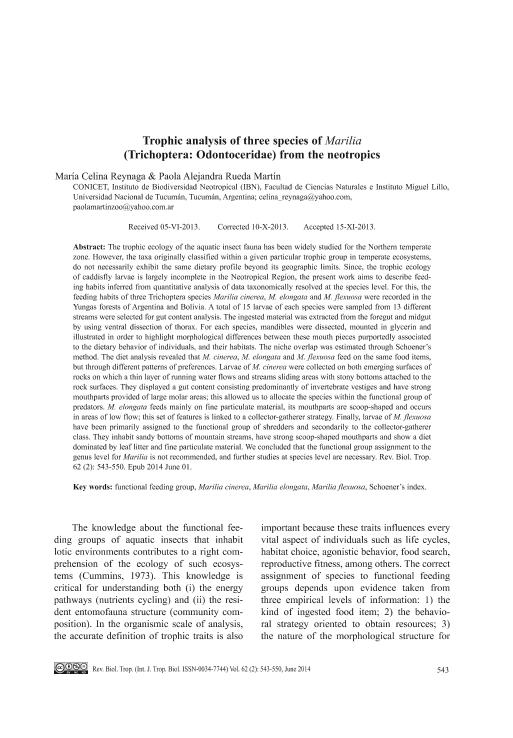Mostrar el registro sencillo del ítem
dc.contributor.author
Reynaga, Maria Celina

dc.contributor.author
Rueda Martin, Paola Alejandra

dc.date.available
2017-12-14T18:35:53Z
dc.date.issued
2014-06
dc.identifier.citation
Reynaga, Maria Celina; Rueda Martin, Paola Alejandra; Trophic analysis of three species of Marilia (Trichoptera: Odontoceridae) from the neotropics; Universidad de Costa Rica; Revista de Biología Tropical; 62; 2; 6-2014; 543-550
dc.identifier.issn
0034-7744
dc.identifier.uri
http://hdl.handle.net/11336/30678
dc.description.abstract
The trophic ecology of the aquatic insect fauna has been widely studied for the Northern temperate zone. However, the taxa originally classified within a given particular trophic group in temperate ecosystems, do not necessarily exhibit the same dietary profile beyond its geographic limits. Since, the trophic ecology of caddisfly larvae is largely incomplete in the Neotropical Region, the present work aims to describe feeding habits inferred from quantitative analysis of data taxonomically resolved at the species level. For this, the feeding habits of three Trichoptera species Marilia cinerea, M. elongata and M. flexuosa were recorded in the Yungas forests of Argentina and Bolivia. A total of 15 larvae of each species were sampled from 13 different streams were selected for gut content analysis. The ingested material was extracted from the foregut and midgut by using ventral dissection of thorax. For each species, mandibles were dissected, mounted in glycerin and illustrated in order to highlight morphological differences between these mouth pieces purportedly associated to the dietary behavior of individuals, and their habitats. The niche overlap was estimated through Schoener’s method. The diet analysis revealed that M. cinerea, M. elongata and M. flexuosa feed on the same food items, but through different patterns of preferences. Larvae of M. cinerea were collected on both emerging surfaces of rocks on which a thin layer of running water flows and streams sliding areas with stony bottoms attached to the rock surfaces. They displayed a gut content consisting predominantly of invertebrate vestiges and have strong mouthparts provided of large molar areas; this allowed us to allocate the species within the functional group of predators. M. elongata feeds mainly on fine particulate material, its mouthparts are scoop-shaped and occurs in areas of low flow; this set of features is linked to a collector-gatherer strategy. Finally, larvae of M. flexuosa have been primarily assigned to the functional group of shredders and secondarily to the collector-gatherer class. They inhabit sandy bottoms of mountain streams, have strong scoop-shaped mouthparts and show a diet dominated by leaf litter and fine particulate material. We concluded that the functional group assignment to the genus level for Marilia is not recommended, and further studies at species level are necessary.
dc.format
application/pdf
dc.language.iso
eng
dc.publisher
Universidad de Costa Rica
dc.rights
info:eu-repo/semantics/openAccess
dc.rights.uri
https://creativecommons.org/licenses/by-nc-sa/2.5/ar/
dc.subject
Functional Feeding Group
dc.subject
Marilia Cinerea
dc.subject
Marilia Elongata
dc.subject
Marilia Flexuosa
dc.subject.classification
Otras Ciencias Biológicas

dc.subject.classification
Ciencias Biológicas

dc.subject.classification
CIENCIAS NATURALES Y EXACTAS

dc.title
Trophic analysis of three species of Marilia (Trichoptera: Odontoceridae) from the neotropics
dc.type
info:eu-repo/semantics/article
dc.type
info:ar-repo/semantics/artículo
dc.type
info:eu-repo/semantics/publishedVersion
dc.date.updated
2017-12-11T19:30:48Z
dc.journal.volume
62
dc.journal.number
2
dc.journal.pagination
543-550
dc.journal.pais
Costa Rica

dc.description.fil
Fil: Reynaga, Maria Celina. Consejo Nacional de Investigaciones Científicas y Técnicas. Centro Científico Tecnológico Conicet - Tucuman. Instituto de Biodiversidad Neotropical. Universidad Nacional de Tucuman. Facultad de Ciencias Naturales e Instituto Miguel Lillo. Instituto de Biodiversidad Neotropical. Instituto de Biodiversidad Neotropical; Argentina
dc.description.fil
Fil: Rueda Martin, Paola Alejandra. Consejo Nacional de Investigaciones Científicas y Técnicas. Centro Científico Tecnológico Conicet - Tucuman. Instituto de Biodiversidad Neotropical. Universidad Nacional de Tucuman. Facultad de Ciencias Naturales e Instituto Miguel Lillo. Instituto de Biodiversidad Neotropical. Instituto de Biodiversidad Neotropical; Argentina
dc.journal.title
Revista de Biología Tropical

dc.relation.alternativeid
info:eu-repo/semantics/altIdentifier/doi/http://dx.doi.org/10.15517/rbt.v62i2.9959
dc.relation.alternativeid
info:eu-repo/semantics/altIdentifier/url/https://revistas.ucr.ac.cr/index.php/rbt/article/view/9959
Archivos asociados
